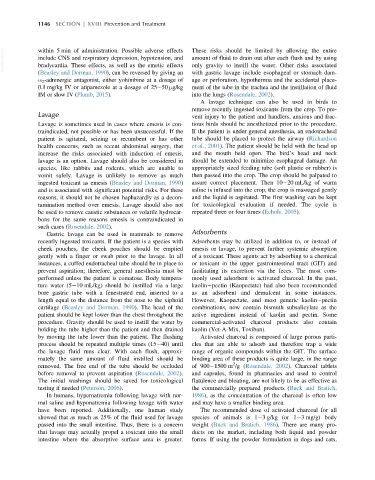Page 1215 - Veterinary Toxicology, Basic and Clinical Principles, 3rd Edition
P. 1215
1146 SECTION | XVIII Prevention and Treatment
VetBooks.ir within 5 min of administration. Possible adverse effects These risks should be limited by allowing the entire
amount of fluid to drain out after each flush and by using
include CNS and respiratory depression, hypotension, and
only gravity to instill the water. Other risks associated
bradycardia. These effects, as well as the emetic effects
(Beasley and Dorman, 1990), can be reversed by giving an with gastric lavage include esophageal or stomach dam-
α 2 -adrenergic antagonist, either yohimbine at a dosage of age or perforation, hypothermia and the accidental place-
0.1 mg/kg IV or atipamezole at a dosage of 25 50 μg/kg ment of the tube in the trachea and the instillation of fluid
IM or slow IV (Plumb, 2015). into the lungs (Rosendale, 2002).
A lavage technique can also be used in birds to
remove recently ingested toxicants from the crop. To pre-
Lavage vent injury to the patient and handlers, anxious and frac-
Lavage is sometimes used in cases where emesis is con- tious birds should be anesthetized prior to the procedure.
traindicated, not possible or has been unsuccessful. If the If the patient is under general anesthesia, an endotracheal
patient is agitated, seizing or recumbent or has other tube should be placed to protect the airway (Richardson
health concerns, such as recent abdominal surgery, that et al., 2001). The patient should be held with the head up
increase the risks associated with induction of emesis, and the mouth held open. The bird’s head and neck
lavage is an option. Lavage should also be considered in should be extended to minimize esophageal damage. An
species, like rabbits and rodents, which are unable to appropriately sized feeding tube (soft plastic or rubber) is
vomit safely. Lavage is unlikely to remove as much then passed into the crop. The crop should be palpated to
ingested toxicant as emesis (Beasley and Dorman, 1990) assure correct placement. Then 10 20 mL/kg of warm
and is associated with significant potential risks. For these saline is infused into the crop, the crop is massaged gently
reasons, it should not be chosen haphazardly as a decon- and the liquid is aspirated. The first washing can be kept
tamination method over emesis. Lavage should also not for toxicological evaluation if needed. The cycle is
be used to remove caustic substances or volatile hydrocar- repeated three or four times (Echols, 2005).
bons for the same reasons emesis is contraindicated in
such cases (Rosendale, 2002).
Gastric lavage can be used in mammals to remove Adsorbents
recently ingested toxicants. If the patient is a species with Adsorbents may be utilized in addition to, or instead of
cheek pouches, the cheek pouches should be emptied emesis or lavage, to prevent further systemic absorption
gently with a finger or swab prior to the lavage. In all of a toxicant. These agents act by adsorbing to a chemical
instances, a cuffed endotracheal tube should be in place to or toxicant in the upper gastrointestinal tract (GIT) and
prevent aspiration; therefore, general anesthesia must be facilitating its excretion via the feces. The most com-
performed unless the patient is comatose. Body tempera- monly used adsorbent is activated charcoal. In the past,
ture water (5 10 mL/kg) should be instilled via a large kaolin pectin (Kaopectate) had also been recommended
bore gastric tube with a fenestrated end, inserted to a as an adsorbent and demulcent in some instances.
length equal to the distance from the nose to the xiphoid However, Kaopectate, and most generic kaolin pectin
cartilage (Beasley and Dorman, 1990). The head of the combinations, now contain bismuth subsalicylate as the
patient should be kept lower than the chest throughout the active ingredient instead of kaolin and pectin. Some
procedure. Gravity should be used to instill the water by commercial-activated charcoal products also contain
holding the tube higher than the patient and then drained kaolin (Vet-A-Mix, Toxiban).
by moving the tube lower than the patient. The flushing Activated charcoal is composed of large porous parti-
process should be repeated multiple times (15 40) until cles that are able to adsorb and therefore trap a wide
the lavage fluid runs clear. With each flush, approxi- range of organic compounds within the GIT. The surface
mately the same amount of fluid instilled should be binding area of these products is quite large, in the range
2
removed. The free end of the tube should be occluded of 900 1500 m /g (Rosendale, 2002). Charcoal tablets
before removal to prevent aspiration (Rosendale, 2002). and capsules, found in pharmacies and used to control
The initial washings should be saved for toxicological flatulence and bloating, are not likely to be as effective as
testing if needed (Peterson, 2006). the commercially prepared products (Buck and Bratich,
In humans, hypernatremia following lavage with nor- 1986), as the concentration of the charcoal is often low
mal saline and hyponatremia following lavage with water and may have a smaller binding area.
have been reported. Additionally, one human study The recommended dose of activated charcoal for all
showed that as much as 25% of the fluid used for lavage species of animals is 1 3 g/kg (or 1 3 mg/g) body
passed into the small intestine. Thus, there is a concern weight (Buck and Bratich, 1986). There are many pro-
that lavage may actually propel a toxicant into the small ducts on the market, including both liquid and powder
intestine where the absorptive surface area is greater. forms. If using the powder formulation in dogs and cats,

